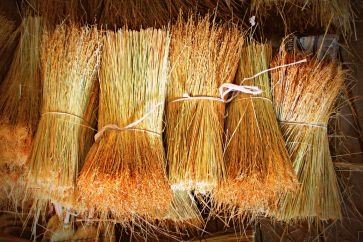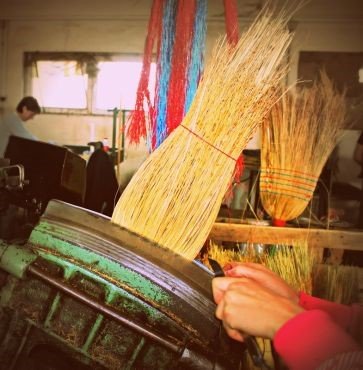Introduction


Procedure Of Making
1. The factory receives the broomcorn, the broom’s raw material, already packaged and processed. The bundles are sorted according to their length and fiber color. A bale of about 120 lb (54 kg) contains bundles in a group. Before being given to the operator, broomcorn must be quickly submerged in water to be used effectively. A crane is used to lift each bale, which is then immersed for ten seconds in a water tank. The crane is then used to remove the bundles from the water.
2. Workers separate the smaller bundles contained within the wet bales and break apart the wet bales. The bundles are rolled to operators who sit at broom-making equipment before being placed on racks.
3. A broom-making machine’s operator uses broomcorn and solid handles at the device. The operator selects a specific handle. The operator inserts a metal wire into a hole that has been drilled close to the handle’s bottom. The insides of the broom are then applied first. The broom’s center is formed by pressing the lowest-grade grass around the wooden handle. The wire that is attached to the handle through the hole holds this thick bundle of grass tightly to the handle.
4. After that, smaller bundles of lower-grade grasses are arranged along each side of the center bundle of grass to shape the broom’s shoulders and sides. More tinned wire is used to attach this corn side to the central grass pile. This wire is manually wrapped tightly around the side corn and the main body of grass.
5. The operator uses a knife to cut the grass straight above the wire.
6. The exterior of the broom—the broomcorn we see when we look at a broom—is now added over this foundation of lower-grade broomcorn or other grasses. Attached to the broom is the hurl, the highest grade of broomcorn utilized in a broom. It covers the center section and shoulders when laid on top of them. The same white metal wire used earlier in the process is used to attach the hurl to the broom physically.
7. The rundown is the final step in the construction process. The operator nailed off the wire that holds the hurl to the handle before nailing the cut end to the wooden handle. The broomcorn and grasses are now securely fastened to the broom.
8. The brooms are currently being built but are not yet finished. The broomcorn must be completely dried out before the broom can be completed. The brooms are transported into an enormous, thermostatically controlled drying room using a pallet or rack. Depending on the weather, the brooms are left in this vast, hot room for five to six hours. The heat kicks in, and the broomcorn has completely dried when instruments in the room indicate that no more moisture is being released from the brooms.
9. Now that the brooms are seeded, cylinders roll vertically over the broomcorn to remove all seeds and any small pieces of broomcorn that aren’t fastened to the handle and will fall out quickly when used.
10. The seeded brooms are taken to sewing machine operators, who thread them with thick twine through a heavy-duty sewing machine with two needles. The machine flattens the brooms and keeps their shape thanks to the double, triple, or quadruple rows of sewing that hold the grasses in place (depending on the machine and the company). The flattening process of sewing the brooms takes about 45 seconds.
11. Carts transport the brooms to final finishing, where they are trimmed to an even bottom, packaged, and sent out for distribution.
Conclusion
This information about the manufacturing process of brooms is only provided to ensure that the brooms are made with first-rate quality material and are good to use.























